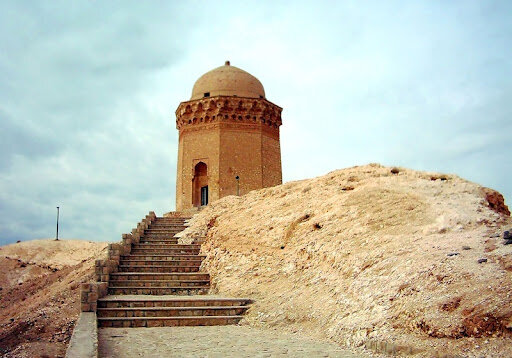Off-the-beaten-path destinations: Gonbad-e Aali

TEHRAN – Built at the summit of a small desert hill, Gonbad-e Aali, which is a mudbrick domed tomb tower, is located three kilometers to the east of Abarkuh, along the road that leads to Yazd in the central Iranian plateau.
The patron for this monument is Firuzan, a member of the local Firuzanid dynasty in Abarkuh. He built this monument in 1055 for his father, Amid ad-Din Shams ad-Daula, and his mother, whose name is not known.
According to Archnet, the tomb tower, which is also called Gonbad-e Ali, consists of an octagonal chamber that sits on a low base with eight unequal sides and a tall, projecting muqarnas cornice.
The chamber tapers inward on the exterior so that the structure is wider at the bottom than it is below the cornice. The entrance to the chamber has been located on the northeast side of the building.
The structure is now domed, but the extension of the cornice beyond this dome suggests that it was also capped by a pyramidal roof, as was customary of tombs in this region.
The tomb is constructed almost entirely of rubble masonry with brick used only in the inscriptions and in the construction of the interior dome. The walls are left plain while the cornice and the entrance receive most of the decorative treatment. The cornice of the monument is a three-tier muqarnas, which tapers outward. Below the muqarnas is a band of Kufic inscriptions in Arabic containing the name of the builder and the name of the person to whom it was dedicated.
It is worth mentioning that the entry is set inside a deep niche crowned by a semi-vault and placed within a rectangular outer frame. The entrance is flanked by two columns, of which only the cavities remain. Inside the niche, above the doorway, is another inscription, written in Kufic style that refers to the patron’s mother as “seiyyeda”, although her full name is not decipherable.
In addition, a band of niches, two on each side, decorate the walls below the drum. The transition to the drum is achieved with eight simple squinches located at the corners of the octagon. Four openings in the dome and a window on the side of the chamber illuminate the interior.
Located 140 km southeast of Yazd in a plain with the height of 1510 meters above the sea level on the way of Yazd- Eqlid-Yasuj, Abarkouh was once on the Silk Road in ancient times. The climate of Abarkooh is arid and semi-desert.
Moreover, the town is famed for its several historical castles and fortresses as well as being home to a 4000-year-old cypress, which is inscribed on the National Heritage list. Venetian merchant and explorer Marco Polo described the tree as one of the most stunning cypress trees he had ever seen in Iran.
AFM
